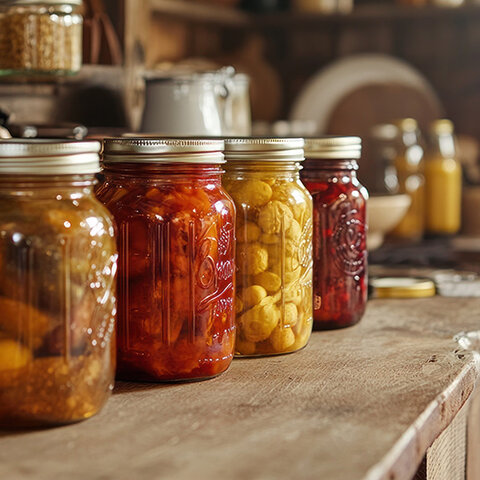
Clostridium botulinum is an anaerobic, sporeforming bacteria that produces a neurotoxin. The bacteria can exist as a vegetative cell or a spore. The spore is the dormant state of the bacteria and can exist under conditions where the vegetative cell cannot. When conditions are right, the spore will grow into the vegetative cell. When the vegetative cells grow to high numbers, this bacteria produces the toxin. The vegetative cells of Clostridium botulinum are destroyed by heat but the spore is very resistant to heat. Temperatures well above 100°C (212°F) are needed to destroy the spore. The bacteria and the spore are inhibited from growing in acid environments.
Sources of the organism:
- Soil (types A and B toxins)
- Oceans and lakes (type E toxin)
Sources of the spore:
- Vegetables
- Fish
- Meat
- Poultry
Associated foods:
- Home canned low acid foods
- Honey (infant botulism)
- Baked Potatoes
- Fried onions
- Garlic in oil mixtures
Microorganism Characteristics: Gram positive rod-shaped sporeforming anaerobic bacteria that forms a neurotoxin. Seven toxin types are known and designated A,B,C,D,E,F, and G.
The Disease: Botulism results from consumption of foods contaminated with the preformed toxin. Toxin types A, B, E and rarely F are most often are associated with botulism in humans. Type A and B is most often associated with soil and Type E is associated with water (seafood).
Infant botulism results from the growth and toxin production of Clostridium botulinum in the intestinal tract of infants rather than from eating foods containing the preformed toxin.
Symptoms include:
- Double vision
- Droopy eye lids
- Difficulty speaking and swallowing
- Difficulty with breathing
- Paralysis
Onset time:
- 12-36 hours
Infective Dose:
- Humans are so susceptible to botulism that if very small amounts of the toxin are consumed, they will become ill.
Duration of symptoms:
- Patients with severe cases that involve paralysis of the respiratory muscles may need mechanical ventilation and intensive care for weeks or months.
Control:
- Proper preservation methods for canning low acid foods (vegetables, meat, poultry).
- Acidification of foods below pH 4.6.
- Reduction of water activity to 0.85 or below.
- Do not feed honey to children under the age of 1 year.
- Do not temperature abuse vacuum packaged food or MAP (modified atmosphere packaged) food.
Sources:
About Botulism, Center for Disease Control and Prevention (CDC)
Bad Bug Book, Foodborne Pathogenic Microorganisms and Natural Toxins. Second Edition., Food and Drug Administration (FDA)
Botulism, World Health Organization
This article has been peer-reviewed. It was updated in 2024.
Tags:



